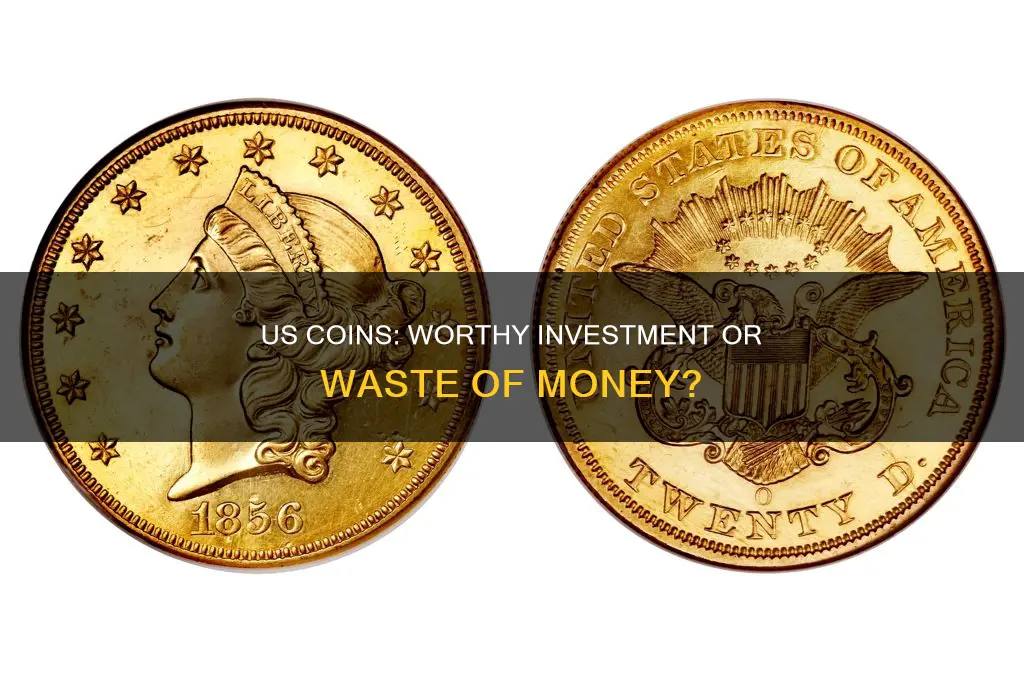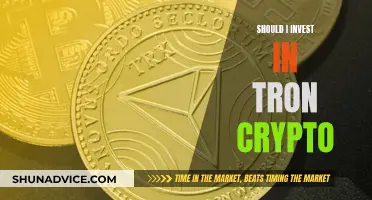
Investing in US coins can be a profitable and rewarding venture, but it's important to approach it with caution and knowledge. The value of a coin is derived from its bullion value, or the worth of the metal it contains, and its collector or numismatic value, which is influenced by factors like rarity and condition. While investing in rare coins can be lucrative, it's a long-term strategy that requires careful research and an understanding of the market. US Mint coins, for instance, may not have the same value as they did in the past due to mass production. However, certain rare US coins, such as the 1933 Double Eagle, have fetched record-breaking prices at auctions.
What You'll Learn

US Mint coins: a good investment?
Coin collecting is a fun hobby for many, but it can also be a profitable investment strategy. The value of a coin comes from its bullion value and its collector or numismatic value. The bullion value is the physical metal contained in the coin, while the collector value is influenced by factors such as rarity and condition.
US Mint coins can be a good investment, but it depends on the type of coin and the individual's collecting strategy. The best US Mint coins to invest in are those with historic and aesthetic value, as these tend to have higher resale prices. Additionally, rare coins with low mintages and those in uncirculated condition are more valuable.
US Mint coins with reliable purity levels include gold and silver options. The introduction of US Mint bullion coins is also a good investment today due to their high value. However, not all US Mint coins are worth investing in. For example, coins from the Franklin Mint and other premium collectibles mints, such as the Bradford Exchange, usually do not have any premium aftermarket value among coin collectors and investors.
When investing in US Mint coins, it is important to buy from reputable dealers and avoid TV shopping networks and premium "mints" that sell coins for exorbitant prices. It is also crucial to perform adequate research, as investing in rare coins can be more complicated than traditional investments.
Coin collecting can be a great way to diversify an investment portfolio, but it may not be ideal for those seeking short-term profits. The value of rare coins can fluctuate, and it may take time to see significant profits. However, with the right knowledge and strategy, investing in US Mint coins can be a lucrative and enjoyable endeavour.
The Ultimate Guide to Investing in Bitcoin Without Cost
You may want to see also

Rare coins: a profitable investment?
Coin collecting is a fun hobby for many, but it can also be a profitable investment strategy. Rare coins, in particular, can be a good way to diversify your portfolio and potentially make some money. However, there are some things to keep in mind before diving into the world of rare coin investing.
The Benefits of Investing in Rare Coins
Investing in rare coins offers several advantages. Firstly, it can add diversity to your portfolio if you primarily focus on stocks and bonds. Rare coins are considered a commodity-like investment, and their value is typically influenced by factors such as demand rather than market trends. This means that their value can remain stable even when the stock market is volatile. Additionally, rare coins often have historical and aesthetic value, which can increase their worth over time.
Another benefit of investing in rare coins is their potential for long-term gains. Historically, rare coins have offered significant profit potential, with prices of elite coins appreciating by more than 1000% from 1976 to 1980 and 600% from 1982 to 1989, according to a rare-coin newsletter, Finest Known.
Factors Affecting Coin Value
When investing in rare coins, it's important to understand the factors that influence their value. The first source of value is the physical metal content, known as the bullion value. As many collectible coins are made from precious metals like gold or silver, their value is tied to the spot price of these metals.
The second source of value is the collector or numismatic value, which applies mainly to antique and rare coins. This value is harder to determine and depends on factors such as rarity and the condition of the coin. The fewer examples of a coin that were minted, the higher its collector value is likely to be. Additionally, coins in uncirculated condition tend to command higher prices from buyers who value their numismatic appeal.
Tips for Getting Started in Rare Coin Investing
If you're new to rare coin investing, it's recommended to start by focusing on bullion value. Investing in modern bullion coins, such as Canadian Maple Leaf silver coins or American Gold Eagles, can be a great way to build a foundation. These coins contain high-grade gold or silver, making them excellent precious metal investments, while also being aesthetically pleasing.
It's also important to specialize your investment selection. Choose a specific theme, time period, or denomination to guide your investments and stay focused on building within that area. This will increase the likelihood of your collection gaining value over time.
Additionally, it's crucial to scrutinize each addition to your collection carefully. Know what you're looking for, and examine coins to ensure they fit within the direction you want to take your collection. It's also recommended to start with a small investment and only invest larger amounts as you gain experience and knowledge.
Potential Downsides of Rare Coin Investing
While rare coin investing can be profitable, there are some potential downsides to consider. Firstly, earning money from rare coins can take time. If you're looking for short-term profits, coin flipping might be a strategy to consider, but it comes with risks.
Another thing to keep in mind is the potential for market fluctuation and volatility in the rare coin market. Coin prices depend on supply and demand, and if a particular coin gains popularity, its price can soar only to crash later if its popularity wanes.
Lastly, it's important to be aware of the potential for counterfeit or altered coins. Always buy coins from reputable coin dealers, and consider dealing only in certified coins that have been inspected and graded by a recognized organization.
In conclusion, investing in rare coins can be a profitable venture, but it requires knowledge, research, and a long-term perspective. By understanding the factors that drive coin value and carefully curating your collection, you can increase your chances of making successful investments in this unique asset class.
Bitcoin: Investment Bubble or the Future of Finance?
You may want to see also

Bullion vs numismatics
Bullion coins are gold and silver coins acquired for their precious metal content. They are often available for much less than numismatic coins. Their value is driven primarily by their underlying precious metal content. The bullion market is straightforward, liquid, and easy to grasp. The value of a bullion coin is based on the type and weight of the metal.
On the other hand, numismatic coins are considered collectibles and are valued for their rarity. They are not produced in modern times and are usually purchased by collectors. Their value is driven primarily by intangible factors such as age, rarity, year of issue, design, and the mint at which they were struck. The numismatics market is complex, illiquid, and involves a steep learning curve. The value of a numismatic coin is based on difficult-to-quantify and ever-changing metrics such as demand for the coin, market timing, coin condition, rarity, age, country of origin, and method of auctioning.
When deciding whether to invest in bullion or numismatic coins, it is important to consider your primary objectives. If you are interested in coins from a historical or collecting perspective, numismatic coins may be a good option. However, if you are searching for a way to invest for your future or are concerned about inflation and currency depreciation, bullion coins may be a better choice.
It is also important to note that unscrupulous dealers may try to steer customers towards numismatic coins, claiming that they cannot be confiscated. This is a myth, and numismatic coins should not be considered a store of wealth in the same way as bullion coins.
Small Bitcoin Investments: Are They Worth the Risk?
You may want to see also

How to start your coin portfolio
Step 1: Research and Education
The first step to starting your coin portfolio is to conduct thorough research and educate yourself on the different types of coins available for investment. This includes understanding the historical background of the coins, their rarity, and the factors that influence their value. It is also important to learn about the different investment strategies and how to balance your portfolio to manage risk effectively.
Step 2: Determine Your Investment Goals
Before investing in coins, it is crucial to establish clear investment goals. Are you investing for short-term gains or long-term appreciation? Different types of coins and investment strategies may be more suitable depending on your goals. For example, rare coins are typically better suited for long-term investing, while coin flipping aims for short-term profits but carries more risk.
Step 3: Choose a Reputable Dealer
Purchasing coins from a reputable dealer or mint is essential to ensure the authenticity and quality of your investments. Avoid buying from TV shopping networks or dealers that sell coins at exorbitant prices, as these coins may not provide any additional value beyond their bullion or face value. Instead, opt for traditional coin dealers or the official US Mint website, which offers rare coins with high investment potential.
Step 4: Diversify Your Portfolio
When building your coin portfolio, diversification is key. Include a variety of coins such as rare US coins, precious metals like gold and silver bullion coins, and classic coins like the double eagle. Diversification helps reduce the risk associated with market fluctuations and increases the potential for returns.
Step 5: Utilize Portfolio-Managing Tools
Consider using coin portfolio-managing applications or websites to efficiently track and manage your coin investments. These tools allow you to monitor the performance of your overall portfolio, analyze data to make informed buying and selling decisions, and stay updated on price movements. Examples of such tools include CoinBundle, Abra, Robinhood, CoinTracking, and Delta.
Step 6: Regularly Rebalance Your Portfolio
As the value of your coins changes over time, it is important to regularly rebalance your portfolio to maintain its balance and alignment with your investment goals. This may involve buying or selling certain coins to adjust their weight in your portfolio.
Step 7: Seek Mentorship and Guidance
If you are new to coin investing, consider finding a mentor or connecting with experienced coin collectors and investors. They can provide valuable guidance on researching coin values, predicting potential returns, and navigating the complexities of the coin market. Joining coin clubs, attending coin shows, and reading books and articles can also enhance your knowledge and network in the field.
Remember, investing in coins carries risks, and it is important to conduct thorough due diligence before making any investment decisions.
The Ultimate Guide: Getting Started with Bitcoin
You may want to see also

Common pitfalls to avoid
- TV Shopping Show Dealers and Premium "Mints": These dealers sell commemorative coins at exorbitant prices, often marketing them as old and rare when they can be purchased for a much more reasonable amount from a reputable coin dealer or at a local coin show.
- National Collector's Mint: The United States Mint has issued warnings about this company's misleading advertisements, particularly regarding their "Freedom Tower" coins, which imply a meaningful amount of precious metal when there is not.
- Franklin Mint & Similar Companies: While they do sell genuine bullion coins, these companies are aggressive marketers, and their coins usually do not have any premium aftermarket value among coin collectors and investors.
- Spurious Sets: These are sets of lower-grade common coins assembled according to some theme, often related to historical events or celebrities. They are usually genuine but will likely not be worth what you paid for them when you sell them.
- Modified Coins: Genuine US Mint products that have been altered with holographic stickers or colouring are considered "damaged" by coin collectors and numismatists. You will only get the bullion value when you sell them, and some dealers will further discount the buying price due to added impurities.
- Not Exploring Different Types of Gold Investment Options: It is important to understand the variety of products available when investing in gold. Options include certified investment-grade coins, gold bullion coins and bars, and collectible gold coins.
- Failing to Learn About the Logistics of Gold Ownership: Gold investors need to consider secure storage options, such as a safety deposit box at a bank or a safe at home.
- Misunderstanding How Gold Prices Work: The spot price of gold is constantly changing and is calculated by averaging prices from professional gold brokers and traders worldwide. Beware of brokers who charge significantly more than 5-8% over the spot price, as they may be trying to rip you off.
- Investing in Gold for Short-Term Gains: Gold prices fluctuate, and while long-term prices have generally increased, you could see losses if you need to liquidate your gold shortly after purchasing it. Gold and precious metals are better suited for long-term financial security rather than short-term investment gambling.
- Failing to Work with a Trustworthy, Reputable Broker: There are scammers and dishonest brokers who will try to pressure you into buying with scare tactics. As a rule of thumb, don't buy gold from pawn shops, as you will have no recourse if the bullion is not as advertised. Instead, opt for a reputable local dealer.
Blockchain Bitcoin Investment: A Beginner's Guide to Getting Started
You may want to see also
Frequently asked questions
The answer depends on the type of US coin being invested in. Rare US coins can be a good investment, especially for long-term investing. The rarer the coin, the more valuable it is. However, it's important to note that earning money from investing in rare coins takes time.
The value of a coin is influenced by two main factors: the physical metal contained in the coin (bullion value) and its collector or numismatic value. The bullion value of a coin can be calculated by multiplying the number of ounces of metal in a coin by the spot price per ounce of that metal. The numismatic value of a coin depends on buyer sentiment and factors such as rarity and condition.
When investing in US coins, it is recommended to focus on bullion value, especially for beginners. Modern bullion coins, such as American Gold Eagles, are a great way to get started as they contain high-grade gold or silver. It is also important to buy from reputable dealers and research the value and potential future value of coins before investing.







